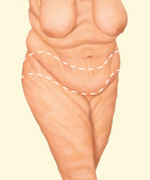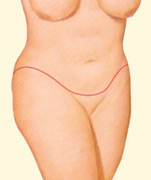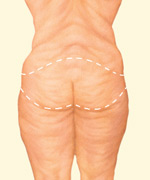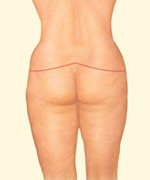A well-toned body with smooth contours often is a sign of fitness achieved by healthy diet and exercise. But exercise cannot always achieve results for individuals who have loose, sagging skin and uneven contours. Aging, sun damage, pregnancy and fluctuations in body weight as well as genetic factors contribute to poor tissue elasticity and may result in sagging of the abdomen, buttocks, thighs, and upper arms.
If you desire a firmer, more youthful looking body contour, then a surgical body lift may help achieve your goals. In general, a body lift reduces excess fat and skin resulting in smoother skin and contours. These physical changes to the body can improve your body image and enhance your self-confidence.
This web page presents an overview of body lift procedures. The best way to learn how body contouring through body lifts can help fulfill your personal goals is a consultation with a plastic surgeon.
What are body lifts?
A body lift is surgery performed to correct excess loose and sagging skin and irregular contours of the:
- Abdominal area, locally or extending around the sides and into the lower back area
- Buttocks, that may be low, flat or shaped unevenly
- Groin that may sag into the inner thigh
- Thigh, including the inner, outer, or posterior thigh, or circumferentially
- Upper arms, including the armpit region
Surgical body lifting improves the shape and tone of the underlying tissue that supports fat and skin. Excess sagging fat and skin is removed to treat conditions caused in part by poor tissue elasticity. In addition, a body lift can improve a dimpled, irregular skin surface, commonly known as cellulite.
Body lifts are not intended strictly for the removal of excess fat. Liposuction alone can remove excess fat deposits where skin has good elasticity and is able to naturally conform to new body contours. In cases where skin elasticity is poor, a combination of liposuction and body lift techniques may be recommended.
Body lifting procedures may be appropriate for individuals who are of stable weight that is reasonably proportionate to their height and body frame. In addition, it is recommended that women considering future pregnancies postpone and abdominal body lift since pregnancy may diminish results. Body lift procedures may be performed on adults of any age who have realistic goals in mind for improvement of their body contour.
Good candidates are:
- Individuals with significant soft tissue looseness in one or multiple body areas
- Healthy individuals who do not have medical conditions that can impair healing or increase risk of surgery
- Non-smokers
- Individuals with a positive outlook and specific goals in mind for body contouring
Where do I begin?
A consultation with your plastic surgeon is the first step to learn how body lifting procedures can improve your body contours. A consultation is designed to fully educate you about your body lift in a non-pressured environment, and will include:
- A discussion of your goals and an evaluation of your individual case
- The options available in body lift surgery
- The likely outcomes of body lifting procedures and any risks or potential complications
- The course of treatment recommended by your plastic surgeon
Evaluation
Overall health and personal outlook can greatly impact the outcome of body contouring surgery, including body lifts. These will be carefully evaluated in your consultation. The success of your procedure, safety and overall satisfaction require that you:
- Honestly share your expectations
- Fully disclose health history, current medications, use of vitamins, herbal supplements, alcohol, tobacco and drugs
- Commit to precisely following all of your plastic surgeon’s instructions
Your Body Lift
Your body lift will be individualized to your specific conditions and the regions to be treated. Conditions that may be improved by a body lift include:
- Dimpled or uneven soft tissue
- Lax, loose skin
- Excess fat and tissue
- Sagging body contours
Many conditions can contribute to tissue that is weak and lacking in tone and firmness, and to uneven or sagging body contours. These most commonly include:
- Weight changes, especially substantial weight loss, such as occurs following gastric bypass surgery
- Stress on the skin and underlying tissue that may result from pregnancy
- The natural aging process causing skin and tissue to lose elasticity and tone over time
- Sun damage and other environmental factors that cause premature skin aging
- Heredity or the genetic make-up that determines one’s body type and skin qualities including cellulite
- Childhood and teenage obesity resulting in premature loss of youthful skin tone
There is no other method of body contouring that can restore body shape, skin appearance, and skin tone as effectively as a body lift. Body lifts are surgical procedures and they require incisions; in some cases, incisions may be extensive. Incision length and pattern depend on the amount and location of skin to be removed, as well as personal preference and surgical judgment. Advanced techniques usually allow incisions to be placed in locations where they can be hidden by most types of clothing and swimsuits.
Other body contouring procedures may be performed separately or in the same surgical session as a body lift, including liposuction and tummy tuck, breast lift or male or female breast reduction. However, not all patients are good candidates for combined procedures. Your case will be evaluated on an individual basis.
Preparing for Surgery
Your plastic surgeon will carefully explain your body lift procedure. Prior to surgery, you will be given specific instructions that may include:
- Pre-surgical considerations, diagnostic testing and medications
- Day of surgery instructions and medications
- Specific information related to the use of anesthesia
- Postoperative care and follow up
In addition, you will be asked to sign consent forms to assure your plastic surgeon that you full understand the procedure or procedures you will undergo and any associated risks and potential complications.
Possible risks of a body lift include bleeding, infection, fluid accumulation, delayed or poor healing, skin loss, blood clots, excessive or widened scars, numbness and other changes in skin sensation and irregular or asymmetric contour or scars. Any surgery carries risks associated with anesthesia. These risks and others will be fully disclosed prior to your consent.
It is important that you address all your questions directly with your plastic surgeon. It is natural to feel some anxiety, whether excitement for the anticipated outcomes or preoperative stress. Discuss these feelings with your plastic surgeon.
Where Your Surgery Will be Performed
A body lift may be performed in your plastic surgeon’s accredited office-based surgical facility, an ambulatory surgical facility or a hospital, possibly with an overnight hospital stay. Procedures are most commonly performed under general anesthesia, although local anesthesia with sedation may be used. These decisions will be based on the requirements of your specific procedure and considerations of patient and surgeon preference. Your plastic surgeon and the assisting staff will fully attend to your comfort and safety.
Following Surgery
Once your procedure is completed, dressings or bandages may be applied to your incisions, and you may be wrapped in an elastic bandage to minimize swelling and support your new contours as you heal. One or more small, thin tubes may be temporarily placed under the skin to drain excess fluid or blood that may collect. Before you are released following surgery, you and an accompanying family member, friend or caregiver will be given specific instructions that may include:
- How to care for the surgical site and drains
- Medications to apply or take orally to aid healing and reduce potential for infection
- Specific concerns to look for at the surgical site or in the overall health
- When to follow-up with your plastic surgeon
Progress and Healing
Initial healing will include swelling at the incision sites. Discomfort is common and can be controlled with medication. You will be instructed to return to light walking as soon as possible to minimize the potential for blood clots and other complications.
You must avoid bending, straining or lifting for several days. Where tightening of the abdomen or thighs is involved, your plastic surgeon may also instruct you to avoid standing fully upright and stressing any internal sutures as they heal, and to sleep with pillows elevating your knees. Follow all instructions carefully, this is essential to the success of your outcome. A return to light, normal activity is possible as soon as you feel ready, usually within 2-3 weeks following surgery.
Initial wound healing may take 7 to 14 days, after which time sutures will be removed if necessary. You will be ready to return to work and normal activity in a few weeks, so long as you do not engage in any heavy lifting or vigorous exercise.
Healing will continue for several weeks as swelling dissipates and incision lines continue to improve. You must practice diligent sun protection until the healing process is fully complete. Continue to follow your plastic surgeons instructions and attend follow-up visits as scheduled.
Results and Outlook
The results of a body lift are visible almost immediately, however it may take several months for your final results to fully develop. Numbness and a firm feeling over the skin’s surface will resolve over time. It may take a year or more for incisions lines to refine and fade to some degree. Although permanent, these lines can usually be hidden by most clothing and swimsuits.
Your new uplifted body contours should be long lasting provided that you maintain your weight and general fitness. As your body ages, it is natural to lose some firmness. However, most of your improvement should be relatively permanent.




